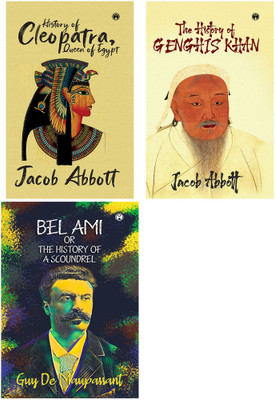History Of Cleopatra Queen Of Egypt, The History Of Genghis Khan & Bel Ami Or The History Of A Scoundrel(Paperback, Multiple Authors)
Quick Overview
Product Price Comparison
This combo product is bundled in India but the publishing origin of this title may vary.Publication date of this bundle is the creation date of this bundle; the actual publication date of child items may vary.ŌĆ£The story of Cleopatra is a story of crime. It is a narrative of the course and the consequences of unlawful love. In her strange and romantic history we see this passion portrayed with the most complete and graphic fidelity in all its influences and effects; its uncontrollable impulses, its intoxicating joys, its reckless and mad career, and the dreadful remorse and ultimate despair and ruin in which it always and inevitably ends." -Jacob Abbott Cleopatra VII was more than the last Macedonian queen of Egypt. She was a Femme fatale of epic Proportion, ensnaring the two mightiest Romans of her time, Julius Caesar and Mark Antony, with her famed beauty and intelligence. The story of Cleopatra reads like a modern thriller. From her murderous family, who were not averse to killing parents, siblings, and their own children, to the Civil Wars between Pompey, Caesar, octavian Augustus, Brutus, and Mark Antony, the tale of this last queen of Egypt is filled with high drama, tension and, ultimately, tragedy. It is a story which, once started, is almost impossible to put down. This is arguably master storyteller Jacob abbottŌĆÖs finest book.,Genghis Khan, or temujin, famous in the West for his and his descendants incursions into Eastern Europe, conquered far more territory and achieved greater political deeds in Asia than anywhere else. In this splendid review of the life and times of the founder and great Khan (emperor) of the Mongol empire, master storyteller Jacob Abbott once again succeeds in retelling history in a breath-taking format which will take the reader on a broad sweep of a historical process which ultimately had a major impact upon Faraway Europe as well. Starting with an overview of the pastoral lifestyle which characterized the nomadic Mongol people of the twelfth century, temujinŌĆÖs early life, his close family intrigues and his inevitable rise to power through his forceful will and natural leadership abilities, the author provides a complete backdrop to the process which led to the creation of one of the largest contiguous land empires of all time.From the unification of the quarrelsome Mongol tribes and their brutal tactics of war, to the overrunning of the great wall of China and the invasions of the lands of the Ottoman empire, the story follows temujinŌĆÖs adventures, with the author carefully distinguishing between what is probable reality and likely myth in order to provide a highly satisfying and exciting adventure story of one of the towering characters of world history.,Young, attractive and very ambitious, George Duroy, known to his admirers as Bel-Ami, is offered a job as a journalist on La Vie francaise and soon makes a great success of his new career. But he also comes face to face with the realities of the corrupt society in which he lives - the sleazy colleagues, the manipulative mistresses, and wily financiers - and swiftly learns to become an arch-seducer, blackmailer and social climber in a world where love is only a means to an end. Written when Maupassant was at the height of his powers, ŌĆ£Bel-AmiŌĆØ is a novel of great frankness and cynicism, but it is also infused with the sheer joy of life - depicting the scenes and characters of Paris in the belle epoque with wit, sensitivity, and humanity. Douglas ParmeeŌĆÖs translation captures all the vigour and vitality of MaupassantŌĆÖs novel. His introduction explores the similarities between Bel-Ami and Maupassant himself and demonstrates the skill with which the author depicts his large cast of characters and the French society of the Third Republic.


